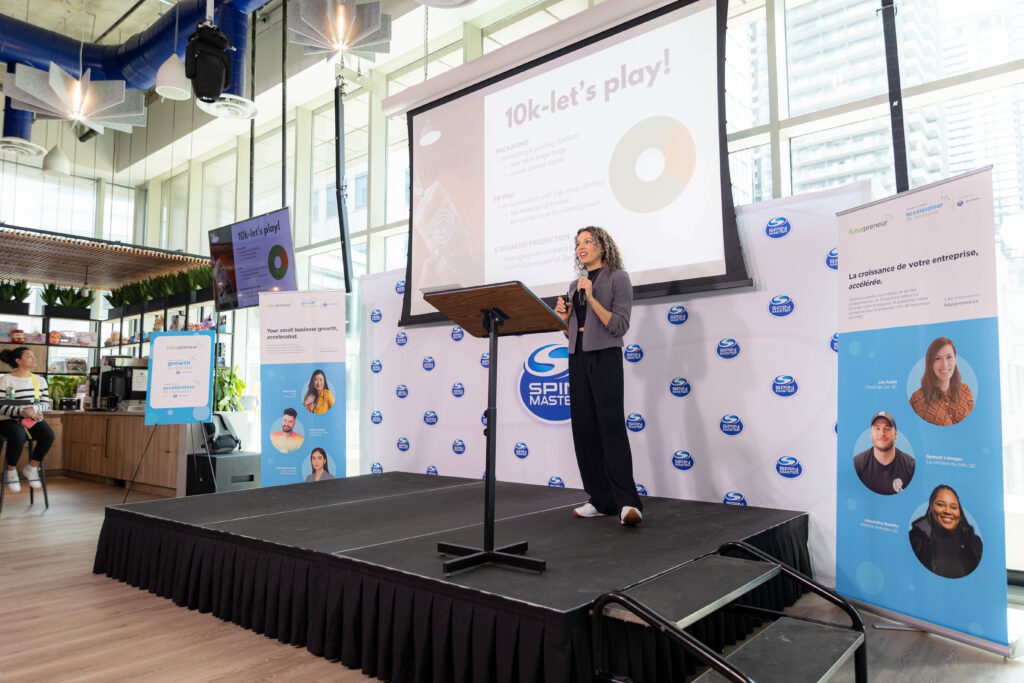
- Business planning and strategy
- Entrepreneurship
- Marketing and sales
10 ways to use ChatGPT to level up your small business
As a small business owner, your marketing, communications, business and product development departments probably consist of … just you.
Even if you have a co-founder or administrative assistant to help out with the various tasks that keep your doors open and customers coming in, you’ve likely got enough tasks to keep twice as many people plenty busy.
Enter the robots! Artificial intelligence, or AI, has reached the mainstream, and a wide variety of AI tools can help you perform a range of tasks that might otherwise cost you valuable time that could be put to better use elsewhere.
What is ChatGPT and what can it do for you?
ChatGPT is a large language model (LLM) program that understands and generates human-like text. One of the most popular AI tools, ChatGPT, like all LLMs, has been “trained” on a massive amount of text from various sources to learn grammar, context, and information on nearly every topic on the internet. The instructions you give ChatGPT are called a prompt, and how you write the prompt influences the quality and relevance of what the bot responds with.
It’s important to understand that while LLMs can make your business life so much easier in so many ways, they aren’t infallible, and they may not always make sense for every use case (see our Tips section for more about this!)
Any time you put AI to work for your business, it’s important to proceed with caution and carefully weigh each situation to determine whether using it is appropriate. Additionally, since all chatbots can produce inaccurate or misleading information — and will sometimes create fictional data to provide an example or fill word count — only use what they generate as a starting point rather than a finished product. Thoroughly fact-check it — and put your own spin on it so that it sounds authentic, not robotic.
ChatGPT is free and easy to use, once you get the hang of it — and once you do, it becomes your very own virtual assistant that can understand what you’re asking it to do and respond accordingly as if engaging in a conversation. Here are 10 tasks ChatGPT can perform for you so you can maximize your time and put your focus where it’s most needed.
1. Write your blog
Creating engaging content is a cornerstone of effective marketing, and a blog is a great way to speak directly to your audience to engage them and help them solve a problem. ChatGPT can write an entire blog post in less time than it takes you to tell it what to write.
Decide on the topic of your blog post, and craft a clear prompt that tells ChatGPT what the topic is and how long it should be. Clearly communicate the main points you want to cover, outline the structure of the blog post, and provide information like the audience, keywords to include, the tone of voice (casual, formal, persuasive), and any additional information you want the bot to include. You can also keep it simple by starting with a general overview and then refining the blog from there with more and more detailed prompts.
Review your blog article for accuracy, clarity, and your brand voice before you post it on your website. Add your own insights, expertise, or personal touch to the blog post. This adds authenticity and value that AI-generated content might lack.
2. Create employee manuals
Whether you own a bakery, boutique, or barber shop, if you have employees, you need an employee manual — and ChatGPT can write it for you.
In your prompt, tell ChatGPT the structure of the employee manual—list the titles of the sections and the key information you want to include. Give an overview of your company’s purpose and mission. Ask the bot to write an introduction and table of contents.
After ChatGPT generates content for a section, review and edit it to ensure accuracy, clarity, and consistency with your company’s voice and style. You can continue to refine the content by refining your prompts.
3. Automate social media campaigns
Maintaining a consistent and engaging social media presence is a time consuming and often challenging task for many small business owners. ChatGPT can write and schedule posts, generate content ideas, respond to comments, and even assess the effectiveness of your social media campaigns.
ChatGPT’s maker, OpenAI, provides API access that allows you to integrate ChatGPT into your social media platform. But before you can use it for social media posts and responses, you need to train it, which involves providing examples of the types of questions and responses you expect from users on social media and the voice and tone of your brand. Identify the triggers that will prompt the chatbot to respond, such as keywords, specific hashtags, or mentions. When the chatbot detects these triggers in incoming social media interactions, it will respond accordingly, based on how you’ve trained it.
4. Generate reports
Using ChatGPT to generate reports requires giving clear instructions and data to the bot and guiding it through the process of creating the report.
Before instructing ChatGPT, clearly outline the purpose and scope of the report. Identify the key objectives and the target audience, and create an outline for the report — break down the content into sections, headings, and subheadings.
Collect all the relevant data, information, and sources that you’ll need to include in the report. This could be data from spreadsheets, databases, research findings, or any other relevant sources.
In your prompt, be detailed and specific about what you want to include in each section. For example: “Write an introduction that provides an overview of the report’s purpose and the main topics covered. In the ‘Methodology’ section, explain the research approach and data collection methods. For the ‘Findings’ section, analyze the data from Sheet A in the attached spreadsheet and summarize the key trends.”
5. Brainstorm ideas
Whether you’re looking for fun and innovative ideas for a holiday sale, new products to offer, topics for a blog or white paper, or creative ways to market to a new demographic, ChatGPT can help you brainstorm ideas and get your creative problem-solving juices flowing.
Start by defining the purpose of your brainstorming session — what do you want to get out of it? Craft a clear and specific prompt, such as, “Generate 10 innovative ideas for a new product in the health and wellness industry” or “Brainstorm 25 content topics for a series of blog posts about sustainable living.”
If you’re looking for other tools and information to empower you to take your business to the next level, Futurpreneur can help. Learn more about how you can become a Futurpreneur today, or check out our business resource centre for articles on startup business planning, operation, sales, marketing and more.
6. Translate anything
In an interconnected business world, language doesn’t have to be a barrier. Using ChatGPT to translate text is simple—just tell it the source language and the target language you want it translated into: “Translate the following text from English to French.” Paste in the text you want to translate.
7. Design surveys
Want to know what your customers’ favorite products are or how satisfied your clients are with your services? Use ChatGPT to create a survey for anything from gauging interest in potential a new product or assessing customer happiness and loyalty.
In the prompt, clearly outline the objectives of your survey. Determine what specific insights you want to gather from respondents—feedback on products, services, customer support, or overall user experience.
Brainstorm and identify the key questions you want to ask in your satisfaction survey. These questions should align with your objectives and cover various aspects of the user experience. Input prompts like “Generate survey questions about customer service” to brainstorm a list of relevant questions, then modify them to fit your specific needs. Tell ChatGPT the type of response scale you want to use, such as a Likert scale (strongly agree, agree, neutral, disagree, strongly disagree) or a numerical scale of 1 to 10.
Set up the survey on a platform like SurveyMonkey, which will collect your data and help you analyze it.
8. Summarize market research
Market research helps you make data-driven decisions by identifying trends, analyzing the competition, and more — and ChatGPT can summarize it for you in a tidy, actionable package.
Collect all the market research data, reports, surveys, and findings that you want to summarize. Review it before you prompt ChatGPT — outline the purpose of the summary and identify the most important and relevant points you want to include in the summary, such as key statistics or customer preferences.
Create a clear and specific prompt for ChatGPT, such as, “Generate a concise summary of our recent market research findings, highlighting the top three trends and key customer preferences.”
9. Simplify booking and scheduling
Whether your client is booking an acupuncture session or reserving a spot in an art class, ChatGPT can automate appointment scheduling and service bookings. Automated scheduling is a great way to enhance your customers’ experience and reduce human error.
Choose a platform or tool that will host your ChatGPT-powered scheduling interface — it could be your website, a messaging app, or a dedicated scheduling tool that’s integrated with ChatGPT’s API.
Design an intuitive, user-friendly conversation flow for scheduling — map out the conversation path and identify common scenarios users might encounter when scheduling, such as requesting a particular service provider, rescheduling or canceling an appointment, or checking availability.
Create prompts and instructions for ChatGPT that guide it through the booking process. Be clear and specific about the information you need from the user and how the AI should respond — teach the bot to understand date and time inputs and interpret phrases like “next week,” “Monday at 3 PM,” or “tomorrow morning.”
Incorporate steps where ChatGPT summarizes your client’s booking details, confirms the appointment, adds it to their Google Calendar or Microsoft Outlook, and sends reminders closer to the appointment date.
10. Write ads
Creating ad campaigns, whether they’re print ads, Google Ads, or social media advertisements. ChatGPT can write quality, engaging ad copy, as long as you provide clear instructions and creative guidance.
Clearly define the objective of your ad or ad campaign — do you want to drive sales, increase brand awareness, promote an event, or achieve another specific goal? Give the chatbot information about your target audience — demographics, preferences, pain points, and motivations.
Create a concise and specific prompt that outlines the purpose of the ad, the key benefits or selling points you want to convey. For example, “Generate a catchy Facebook ad to promote our new summer clothing collection for young adults” or “Write an engaging Instagram ad for our online fitness program targeting busy professionals.”
Instruct ChatGPT to highlight the key selling points or unique features of the product, service, or event you’re promoting. This could include benefits, discounts, special offers, and more.
Ask ChatGPT to generate several versions of the ad copy so you can choose the one that best fits with your brand’s voice and resonates with your audience. Edit the ad for clarity, accuracy, and creativity. Ensure that the copy is free of grammatical errors and flows smoothly.
Tips for getting the most out of ChatGPT — and using it wisely
The more you use ChatGPT, the more intuitive your prompts will become, and the better the bot will perform. When using ChatGPT for your small business, it’s important to keep the following tips in mind:
- Quality control: Regularly review and fine-tune the responses provided by ChatGPT to ensure accuracy and align the content with your brand’s tone, values, and messaging.
- Talk to experts: Talk to a lawyer or an expert in your field before you use ChatGPT for use cases that may have intellectual property or other legal and technical implications, such as if you need to own the copyright to the work or you want a bot to write code for your SAAS.
- Initial training: Spend time training ChatGPT with relevant information about your business to improve the bot’s understanding of your industry, offerings, and specific needs.
- Ethical considerations: Be transparent with customers about their interactions with ChatGPT.
- Terms of use and data privacy policies: Consider privacy and security issues of the text you’re inputting as prompts — especially if it contains sensitive or confidential information.
- The human touch: While AI can increase your efficiency and take on tasks that would take you hours to complete, ChatGPT and other LLMs can’t fully replicate the human touch. Add your own spin to the content for authenticity, genuine interactions, and an empathetic approach.
Ready to start your entrepreneurial journey? Get connected with a dedicated team member to learn more about Futurpreneur’s loan with mentorship and resources. Reach out to start your entrepreneurial journey.




